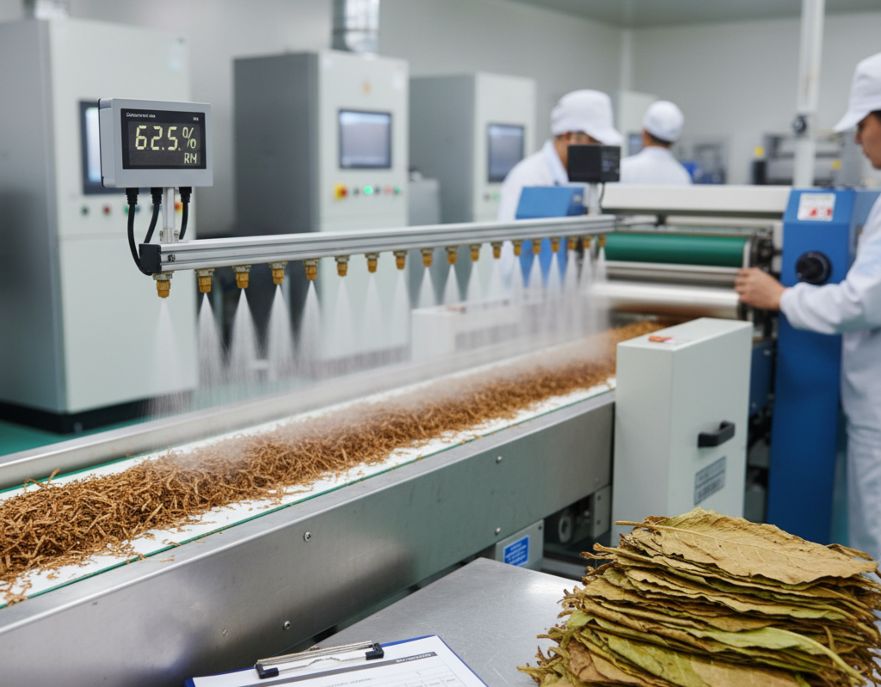
In the world of cigarette production, few factors are as critical as tobacco humidity. From leaf preservation to cigarette flavor and burn rate, the moisture content of tobacco plays a defining role in ensuring consistent quality. Whether in small-scale workshops or large industrial facilities equipped with advanced Tobacco Machinery, humidity control directly impacts every stage of cigarette manufacturing.
This guide explores the science, equipment, techniques, and challenges of humidity optimization, helping manufacturers produce cigarettes that meet the highest standards of taste, texture, and performance.
Tobacco is a naturally hygroscopic material — it absorbs and releases moisture based on surrounding air conditions. Too much or too little humidity can drastically affect the manufacturing process and the final product.
Maintaining the right humidity ensures smooth processing through Cigarette Making Machines and delivers cigarettes with uniform draw and aroma.
The optimal relative humidity (RH) for processed tobacco generally falls between 60% and 70%, with temperature around 20–25°C. However, this range may vary slightly based on the type of tobacco and the stage of production.
Even minor fluctuations can impact cigarette weight, firmness, and flavor profile.
Humidity control is not just about storage; it’s a process integrated into every stage of cigarette production — from leaf conditioning to final packing.
After curing, tobacco must be stored in controlled environments to prevent over-drying or mold formation. Humidity regulation maintains leaf suppleness, preventing cracking during handling and cutting.
Before cutting, tobacco passes through conditioning drums where moisture is restored using steam or water spray. This ensures even blending of different grades and varieties.
When passed through precision Cigarette Making Machines, properly humidified tobacco cuts cleanly, maintaining uniform strand length and density.
During rod formation, humidity consistency ensures even tobacco distribution and burn. Dry tobacco causes air pockets, while excessive moisture leads to uneven compaction.
At the final stage, the finished cigarettes pass through Cigarette Filter Making Machines and packaging lines. Controlled humidity prevents swelling or sticking during wrapping and maintains product freshness inside sealed packs.
Modern cigarette factories rely on advanced environmental systems integrated with Tobacco Machinery.
Industrial humidifiers introduce moisture into the air, while dehumidifiers remove excess humidity. These systems maintain equilibrium, compensating for external weather changes.
Proper ventilation prevents moisture buildup and ensures even humidity distribution across storage areas.
Digital sensors continuously monitor humidity and temperature, alerting operators when adjustments are needed.
Used before cutting and blending, these drums restore moisture to dried leaves, ensuring flexibility and consistency.
Modern storage rooms are insulated, air-conditioned, and humidity-controlled to protect leaf quality over long durations.
Humidity control directly influences the consumer experience and the brand’s reputation.
Brands featured in Cigarette Brands Dubai rely heavily on advanced humidity management to ensure premium quality and uniform performance across markets.
Ignoring proper humidity balance can result in serious manufacturing and quality issues:
To minimize these problems, regular maintenance and humidity audits are essential.
Automation has revolutionized humidity control. In modern facilities equipped with Tobacco Machinery, intelligent systems continuously adjust air parameters to maintain balance.
Maintaining the correct humidity also reduces machine wear and tear, lowering maintenance costs and downtime.
The moisture level in tobacco not only impacts physical handling but also its flavor chemistry.
As a result, manufacturers must balance humidity not just for production efficiency, but also for consistent flavor — a factor that differentiates leading global and regional brands.
Consistent humidity performance requires routine machine servicing. High-quality Spare Parts such as sensors, filters, and valves ensure that the systems regulating air and moisture remain accurate.
Faulty components can cause deviations in humidity, affecting production quality. Investing in durable, well-calibrated parts prevents downtime and preserves tobacco freshness during long production cycles.
To achieve and sustain ideal humidity levels in tobacco manufacturing facilities, consider these best practices:
Optimizing humidity isn’t just about maintaining leaf quality — it also boosts operational efficiency.
Modern cigarette manufacturing integrates digital solutions for more precise humidity regulation:
These innovations are shaping the future of Cigarette Brands Dubai and global tobacco industries, where quality and consistency define competitiveness.
Controlling humidity efficiently also contributes to sustainable manufacturing. Reducing waste, minimizing rejected batches, and using energy-optimized systems lowers environmental impact. Moreover, careful humidity management reduces tobacco leaf spoilage, leading to less agricultural waste.
As sustainability becomes a central focus for global manufacturers, eco-friendly humidity systems are emerging as vital components of responsible cigarette production.
Conclusion
Optimizing tobacco humidity is a cornerstone of successful cigarette manufacturing. From preserving leaf texture and aroma to ensuring smooth machine operation, moisture balance defines the quality and stability of every cigarette produced.
By integrating advanced Tobacco Machinery, efficient Cigarette Making Machines, and precision-driven Cigarette Filter Making Machines, manufacturers can maintain the perfect humidity levels for superior results.
Additionally, the use of high-quality Spare Parts and modern monitoring systems ensures consistent production, minimal waste, and excellent product preservation — allowing leading Cigarette Brands Dubai to maintain their edge in quality and taste.
For manufacturers looking to refine their processes and achieve unmatched product stability, proper humidity management isn’t an option — it’s a necessity.
We specialize in the provision of Tobacco Machinery. Our expertise encompasses not only the trading of machinery but also extends to being a dedicated supplier. This specialization is enriched by our comprehensive solutions tailored for emerging Cigarette Companies. What sets us apart is our ability to offer firsthand insights through our active Cigarette Manufacturing operation in the UAE.